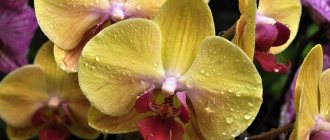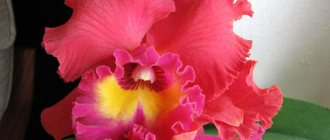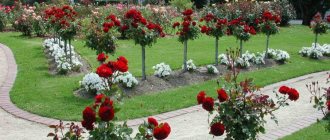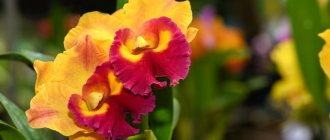The Miltonia orchid comes from warm South American countries with a humid climate, from the orchid family. Includes about 25 different species of orchids, is a perennial herbaceous plant, lives in trees. Outwardly they resemble the Pansy flower.
Many gardeners often have questions about the substrate, choice of pot, watering regime, lighting, relative humidity, temperature conditions at which the plant is kept, feeding and replanting the plant, as well as regarding propagation. The article explains how to properly care for Miltonia orchids.
Features of the plant
It blooms with velvety large flowers, with bright and colorful colors. It has a characteristic pleasant aroma, blooms in summer and autumn, and with good care all year round. Arrows with flowers are not cut off, since they wilt in just a few hours.
Regnelli
Miltonia Regnelli (some reference books incorrectly call it Regnella) - the glossy and sophisticated leaves of this species have earned the delight of many gardeners. The peduncles are thin and knotty, but long, up to half a meter, with about five or less often six buds. The petals of the flowers are white-cream or snow-white, the lip of the lilac flower has patterned veins of dark purple shades. She is quite forgiving of minor defects in care, so novice orchid growers will not be happy with her. Although the flowers do not have an elaborate appearance, their vigorous blooms are quite pretty.
Miltonia Regnelli
Choosing a substrate for an orchid
The substrate sold in stores is not entirely suitable, so it makes sense to tackle the issue yourself - buy or collect pine bark in the forest, peel and boil it, add charcoal, peat, sphagnum moss, which is added to the mixture in small quantities and placed in the upper part soil. It is strongly recommended to replace moss every three months.
Botanical description
Miltonia belongs to the orchid family, which live as epiphytes - they develop in the middle floor of tropical forests, settling on thick and loose, moss-covered trunks of centuries-old trees, launching their dense green short roots into their ancient and soft spongy bark.
Pseudobulbs for food storage are small, seven by five centimeters, pear-shaped or oval, flattened and crowded. The flowers are simple and bright.
The leaves are lanceolate, quite long - up to forty centimeters, hard. Their tips are sometimes slightly bent.
The flowers have a diameter of six to eight centimeters, have crimson or purple longitudinal veins, and the main color is soft pink or lavender.
Nutrition consists of moisture and mineral-organic substances that remain from moss and rain, morning dew and evening fog. Being herbaceous evergreen perennials, they are distinguished by an unusual foliage color for orchids - grayish or yellowish-green. Some Miltonias also have green leaves.
Miltonia creates with its roots some semblance of a ball or nest, into which small organic debris is sometimes poured - it is this that becomes the substrate and source of various useful substances for the orchid flower.
The leaves are lime green, the pseudobulbs are noticeably flattened and appear excessively long. Tolerates both hypothermia and overheating, without reacting to such stress by dropping flowers or withering leaves. Blooms in mid to late summer.
Choosing a pot
During the transplantation process, a plastic transparent pot is selected in order, firstly, to see the state of the root system, and secondly, the process of photosynthesis is taking place.
Each subsequent pot should be 2 cm larger in diameter than the previous one. Drainage holes are made in the lower part of the pot with a nail or screwdriver.
Landing rules
The plant is demanding on soil quality
This is a capricious plant, so it is important to prepare a good substrate, container and carry out proper planting.
Priming
A wet and loose mixture is suitable, which you can prepare yourself at home. Mix pine bark (crushed and pre-steamed) with charcoal, perlite, peat and sphagnum moss.
There is no need to add regular soil, because in it the orchid roots will stop growing and may rot.
Moss is one of the most important components that retains salts and heavy metals contained in the substrate. It is changed every three months.
Capacity
The best planting container is a plastic pot with drainage holes at the bottom. It should be transparent, because the roots of the flower take part in photosynthesis.
The walls are smooth so that the roots are not injured during the process of growth and development.
You can also use lattice flowerpots or wicker ones from twigs and vines. You can hang such flowers, as long as the roots are not exposed to direct sunlight.
Technology and timing
The best time to plant a flower is early spring, when the plant has not yet produced flower buds and is in the dormant phase.
The bottom is sprinkled with a thin layer of substrate, then the roots are lowered, carefully straightened, and the voids are filled with soil mixture so that a small part of the roots remains on the surface.
Over time, the soil will settle and the orchid will take the correct shape. Immediately after planting, the container with the roots is immersed in a basin of warm water for 15 minutes to saturate it with moisture.
The process of watering orchids
Water the orchids either with distillate or with thawed water heated to 30-40 degrees. Do not overdo it with watering, otherwise the root system will rot.
The frequency of watering depends on air humidity and ambient temperature, as well as whether the plant is blooming or not at the moment. Watering is done approximately once every 5 days, and the old water is poured out of the pan and the pot is dried.
Water the orchid by placing it, along with the pot, halfway in a vessel with clean, heated water for 20-25 minutes, and sprinkle the moss on top as well.
Fertilizers
The use of fertilizers is recommended no more than once every 2 weeks. In this case, the use of different types of fertilizers is allowed. The most popular is the classic variety, applied directly to the soil.
You can also use foliar feeding, which is a liquid with nutrients. The plant is sprayed with this liquid, after which it itself absorbs all the substances it needs.
Abundant flowering is a clear sign that fertilizing is beneficial.
Illumination
Orchids do not tolerate direct sunlight; they require indirect light for about 12 hours a day. It is recommended to keep the flower pot in the north-east window in the summer, and in the south in the winter. If there is too much light, the orchid leaves begin to turn yellow, and if there is not enough light, they become dark green, and flowering stops. Depending on the condition of the foliage, the light level is adjusted.
Bloom
Miltonia, unlike other orchids, does not have a clearly defined flower production period. Its tuberidia are capable of producing peduncles always, except for two months of rest. Withered arrows will be replaced by new ones faster if the old peduncle is cut off with a sharp and clean knife close to the substrate - the soil will be healthier and the flowering will become lush.
Miltonia flowering conditions
In order for miltonia to bloom tirelessly, it needs to meet the conditions - high humidity and coolness. good air circulation and soft, dim, but sufficient light.
also important that feeding is constantly supplied - otherwise the flower simply will not be able to constantly produce new arrows.
Miltonia is not allowed during flowering:
- Move.
- Expose to drafts.
- Allowing overheating can not only lead to flowers falling off, but also to plant disease.
Care after flowering
It is important to create an optimal dormant period: coolness and infrequent watering, slightly less light and moderate humidity. In this case, two months will allow the flower stalks to be released over the next eight months - and the tuberidia that have become full of strength can be separated for reproduction.
It is important not to stop monitoring the condition of the soil, excluding flooding and putrefactive processes. Remove drying leaves in time, cutting them off from the base with a sharp, clean knife.
Temperature
Elevated temperatures have a very bad effect on the condition of the plant, since under natural conditions it grows in relative coolness. In winter, permissible temperatures are in the range of 12-18 degrees, in summer the maximum is 25 degrees.
The temperature is controlled using a thermometer; if cooling is necessary, the lower part of the pot can be lined with ice cubes.
Air humidity
Recommended air humidity levels are 60-80%, subject to good ventilation of the room. A sign of lack of moisture is curling of the plant leaves.
To ensure normal humidity for the orchid, the air around it is sprinkled with water, but without splashing on the plant itself. Or you can line the pot with wet expanded clay.
Orchid transplantation
First, remove the flower with the substrate from the old pot, inspect it for the presence of insects, and place it in a solution of cornesil. Dead roots are cut off with previously disinfected scissors.
- Risks of an individual entrepreneur
Orchid seeds: tips for choosing and rules for growing a flower from seeds. Tips for sowing and growing (120 photos + video)
Orchid pot: how to choose the optimal pot. Features of planting orchids with your own hands (145 photos and videos)
The bottom of the new container is lined with expanded clay or small crushed stone to ensure drainage, a plant with a substrate is placed in the middle, and the pot is immersed in Zircon, a fertilizer that improves the adaptation process. For a better understanding of the process, it is recommended to look at the photo instructions for transplanting the Miltonia orchid.
Peace
The miltonia orchid plant may require a kind of dormant period several times during the calendar year; at this time, the growth of the flower completely stops. This is quite normal, but it is necessary to slightly change the conditions of detention. A sign of the onset of this period is the same size of old and young processes.
It is necessary to move the flower to a cooler place, the temperature of which should be up to +15 degrees. Also the place should be dry. The optimal solution would be to place the flower under the shade of trees in the garden, or to artificially create shade indoors.
Reproduction
Reproduction of the Miltonia orchid occurs by pseudobulbs and division of the root system. It is best to divide the plant when replanting it. The rhizome is divided in spring, separating part of the tuber along with the shoot from the orchid. The shoot is planted in a mixture of peat, perlite and humus. Watering is carried out 7 days after transplantation.
The pseudobulb is part of the tuber; it is separated after flowering and planted in a narrow container with peat and sand. For escape, a greenhouse is created using a plastic bag, the bag is opened briefly every day, watering is carried out after 4 days, and after the pseudobulb has germinated, the bag is removed.
LOSS OF ROOT SYSTEM
an orchid such as Miltoniopsis (and similar species, for example, Miltonia), can be caused by many factors, for example, this happens:
- due to improperly organized orchid care (keeping the plant too wet combined with poor lighting and low temperatures, or too infrequent watering in conditions of elevated temperatures);
- as a result of any fungal or bacterial disease;
- or simply from old age (the root system of each individual pseudobulb can function normally for no more than 2-3 years, so the absence of a root system in old pseudobulbs (discovered, for example, during transplantation) is the NORM
).
RESUME of orchids
is to create the most favorable conditions for the plant to grow a new root system.
In this case, you need to remember that due to the structural features of this type of orchid, new roots in the plant appear, as a rule, ONLY FROM NEW SPROUTS
(a little less often on older, ALMOST fully formed pseudobulbs), therefore the primary task is to create the most favorable conditions for regrowth namely new shoots, which in turn will later grow new roots.
Mitoniopsis is a fairly large group, including hybrid representatives of both cold and moderate temperature conditions, which is very important to take into account in the resuscitation of this type of orchid and NEVER try to stimulate the plant in GREENHOUSES
, since this method of resuscitation is optimal for warm and moderately warm plants that can tolerate temperatures up to 32-35 °C without harm to health, which is absolutely contrary to the temperature preferences of Miltoniopsis(s), the maximum temperature of which is 24-25 °C.
Orchids are reanimated using a simple, but quite labor-intensive method: DAILY SOAKING THE ORCHID IN A CONTAINER WITH WATER
. For these purposes, the plant can be placed in an empty pot without holes (for example, a flowerpot) or in some glass vessel and placed in a bright window (in no case in direct sun) at a temperature not lower than + 18 ° C and not higher + 24 °C. Every day in the first half of the day you will need to pour water into the vessel (so that only the bottom of the plant, where the roots were once, is in the water) and leave it like that for about 3-4 hours. As practice has shown, an orchid can remain in water for more than 48 hours without any harm to its health, so if you do not have the opportunity to pour out the water immediately after this period, then you can do this quite safely in the evening, and even after a few days. However, with this regime, it is advisable to carry out the next “watering” procedure not the next day, but not earlier than a day later. At the initial stage of resuscitation, the orchid can be bathed (no more than 2 hours) in a (bio) growth regulator, for example, Epin or Zircon, at the rate of 1 drop per 1 liter of water. However, repeating this procedure more often than once every 3-4 weeks is not recommended. Once every 10-14 days you can use a very weak solution of fertilizer aimed at stimulating plant growth, in other words, with a higher content of nitrogen than phosphorus, for example, NPK = 3-1.5-5, or 6-3-10, etc. .d. In this case, you can not pay much attention to the potassium content.
The total duration of resuscitation can vary from 1 month to 1 year. As a rule, from March to October, due to good lighting, new shoots of orchids grow much more readily than in the darker winter period.
AFTER THE APPEARANCE OF NEW ROOTS
Feeding the orchid should be stopped, but the duration of watering should be increased by at least another 1-2 hours. As a rule, at this stage, the development of roots occurs literally before our eyes, and within the first 7-10 days at least 3-5 new (still very small) roots appear at the base of the new shoot.
As soon as their size reaches 5-7 cm in length, the orchid can be planted as an independent plant in a very small, narrow pot and watered in such a way that the substrate dries well between waterings, but in no case remains completely dry for more than a day. As a substrate, you can use pure conifer bark, pure sphagnum moss, or a mixture of bark and moss. It is also possible to add about 20% fine charcoal. The use of any other materials at this stage is not advisable.
To prevent the orchid from dangling in the new pot and breaking its young roots, it must be secured by cutting the edges of the pot and, as it were, tying the plant itself to the pot with threads.
REMEMBER
, that no matter how accurately you follow the instructions described above,
there is NO GUARANTEE that the REANIMATION of your orchid WILL BE SUCCESSFUL.
All materials presented above are the property of this site, the full or partial publication of which (in accordance with the Law on Copyright and Related Rights) on other resources is prohibited.
World of Orchids
Diseases and parasites
The cause of diseases is mostly a violation of the temperature regime and insufficient humidity. Damage may occur:
- thrips - the leaves become silver in color, with gray spots on the front side;
- scale insect - the leaves begin to stick and become covered with brown plaques;
- whiteflies - the bottom of the leaf becomes covered with white-yellow spots, becomes discolored, and the plant may die;
- scale insect - the stems and leaf blades begin to dry out sharply.
If the air is too humid and cold, the orchid begins to rot. If signs of disease appear, damaged areas are removed and, if necessary, replanted in fresh soil.











